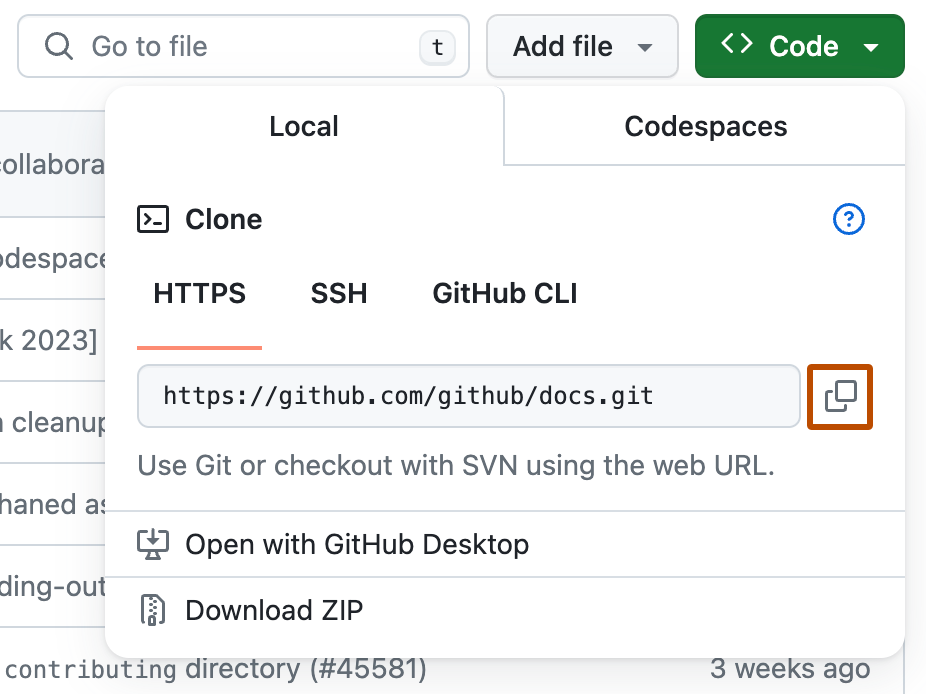You can only make commits on pull request branches that:
- Are opened in a repository that you have push access to and that were created from a fork of that repository
- Are on a user-owned fork
- Have permission granted from the pull request creator
- Don't have branch restrictions that will prevent you from committing
Only the user who created the pull request can give you permission to push commits to the user-owned fork. For more information, see Allowing changes to a pull request branch created from a fork.
Note
You can also make commits to a pull request branch from a fork of your repository through your GitHub Enterprise Server instance by creating your own copy (or fork) of the fork of your repository and committing changes to the same head branch that the original pull request changes were created on. For some general guidelines, see Creating a pull request from a fork.
-
On GitHub, navigate to the main page of the fork (or copy of your repository) where the pull request branch was created.
-
Above the list of files, click Code.

-
Copy the URL for the repository.
-
To clone the repository using HTTPS, under "HTTPS", click .
-
To clone the repository using an SSH key, including a certificate issued by your organization's SSH certificate authority, click SSH, then click .
-
To clone a repository using GitHub CLI, click GitHub CLI, then click .

-
-
Open TerminalTerminalGit Bash.
Tip
If you prefer to clone the fork using GitHub Desktop, then see Cloning a repository.
-
Change the current working directory to the location where you want to download the cloned directory.
cd open-source-projects -
Type
git clone, and then paste the URL you copied in Step 3.git clone https://HOSTNAME/USERNAME/FORK-OF-THE-REPOSITORY -
Press Enter. Your local clone will be created.
$ git clone https://HOSTNAME/USERNAME/FORK-OF-THE-REPOSITORY > Cloning into `FORK-OF-THE-REPOSITORY`... > remote: Counting objects: 10, done. > remote: Compressing objects: 100% (8/8), done. > remove: Total 10 (delta 1), reused 10 (delta 1) > Unpacking objects: 100% (10/10), done.Tip
The error message "fatal: destination path 'REPOSITORY-NAME' already exists and is not an empty directory" means that your current working directory already contains a repository with the same name. To resolve the error, you must clone the fork in a different directory.
-
Navigate into your new cloned repository.
cd FORK-OF-THE-REPOSITORY -
Switch branches to the compare branch of the pull request where the original changes were made. If you navigate to the original pull request, you'll see the compare branch at the top of the pull request.
In this example, the compare branch is
test-branch:git checkout TEST-BRANCHTip
For more information about pull request branches, including examples, see Creating a pull request.
-
At this point, you can do anything you want with this branch. You can push new commits to it, run some local tests, or merge other branches into the branch. Make modifications as you like.
-
After you commit your changes to the head branch of the pull request you can push your changes up to the original pull request directly. In this example, the head branch is
test-branch:$ git push origin test-branch > Counting objects: 32, done. > Delta compression using up to 8 threads. > Compressing objects: 100% (26/26), done. > Writing objects: 100% (29/29), 74.94 KiB | 0 bytes/s, done. > Total 29 (delta 8), reused 0 (delta 0) > To https://HOSTNAME/USERNAME/FORK-OF-THE-REPOSITORY.git > 12da2e9..250e946 TEST-BRANCH -> TEST-BRANCH
Your new commits will be reflected on the original pull request on your GitHub Enterprise Server instance.